President's Update: Spring 2021
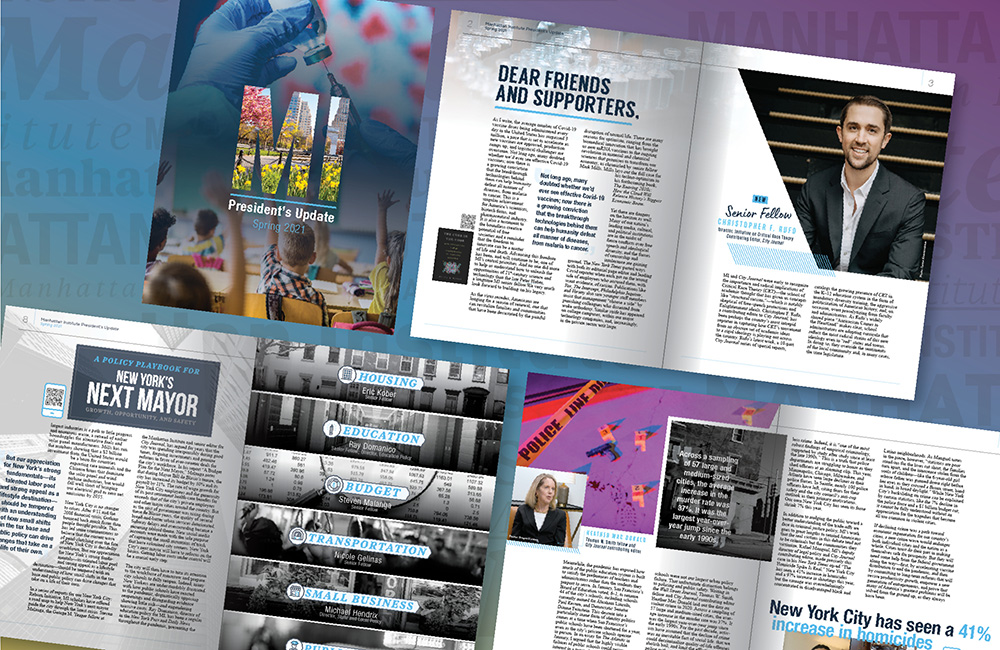
DEAR FRIENDS AND SUPPORTERS,
As I write, the average number of Covid-19 vaccine doses being administered every day in the United States has surpassed 3 million, a pace that is set to accelerate as new vaccines are approved, production ramps up, and logistical challenges are overcome. Not long ago, many doubted whether we’d ever see effective Covid-19 vaccines; now there is a growing conviction that the breakthrough technologies behind them can help humanity defeat all manner of diseases, from malaria to cancer. This is a singular achievement for America’s scientists, biotech firms, and pharmaceutical industry. It is also a testament to the boundless creative potential of free societies and a reminder that the freedom to innovate can be a matter of life and death. Advancing this freedom has been, and will continue to be, one of MI’s central priorities. And no one did more to help us understand how to unleash the opportunities of 21st-century science and technology than the late Peter Huber, a longtime MI senior fellow. We very much look forward to building on his legacy.
As the virus recedes, Americans are longing for a season of renewal, one that can revitalize families and communities that have been devastated by the painful disruption of normal life. There are many reasons for optimism, ranging from the biomedical innovation that has brought us new mRNA vaccines to the ongoing revolution in material and chemical sciences that promises to transform our economy, as chronicled by senior fellow Mark Mills. Mills lays out the full case for his techno-optimism in his forthcoming book, The Roaring 2020s: How the Cloud Will Release History’s Biggest Economic Boom.
“Not long ago, many doubted whether we’d ever see effective Covid-19 vaccines; now there is a growing conviction that the breakthrough technologies behind them can help humanity defeat all manner of diseases, from malaria to cancer.”
Yet there are dangers on the horizon as well. Many of our nation’s leading media, cultural, and political institutions are in the midst of fierce conflicts over free speech and ideological diversity, and the forces of censorship and intolerance are gaining ground. The New York Times parted ways with both its editorial page editor and leading Covid reporter when each got on the wrong side of employees who accused them, with scant evidence, of racism. Publications like Vox, The Intercept, Philadelphia Inquirer, and Variety also saw younger staff members insist that management “choose a side” by punishing colleagues who dissented from woke orthodoxy. Similar strife has appeared on college campuses, within our major technology companies, and, increasingly, in the private sector writ large.
MI and City Journal were early to recognize the importance and radical implications of Critical Race Theory (CRT)—the school of academic thought that has given us concepts like “structural racism,”—which is notably skeptical of free-speech protections and Enlightenment ideals. Christopher F. Rufo, a contributing editor to City Journal, has been perhaps the country’s most intrepid reporter in capturing how CRT’s movement from an obscure set of academic ideas to a rigid ideology is playing out across the country. Rufo’s latest work, a 10-part City Journal series of special reports, catalogs the growing presence of CRT in the K–12 education system in the form of mandatory diversity training, the aggressive politicization of American history, and, on occasion, overt proselytizing from faculty and administrators. As Rufo’s widely shared piece “Antiracism Comes to the Heartland” makes clear, school administrators are adopting curricula that reflect the most radical strains of this new ideology even in “red” states and towns. In doing so, they override the sentiments of the local community and, in many cases, the state legislature.
Meanwhile, the pandemic has exposed how much of the public education system is built to satisfy the preferences of teachers and administrators rather than the students they purport to serve. In January, San Francisco’s Board of Education voted, 6–1, to rename 44 of the city’s schools, including schools currently named for Abraham Lincoln, Paul Revere, and Democratic Senator Dianne Feinstein. This descent into a particularly inane form of identity politics comes at a time when San Francisco’s public schools have been shuttered for a year, even as the city’s private schools operate in person. In an essay for The Atlantic in January, I argued that the highly visible failures of public schools could revive interest in a more pluralistic education system, including in the upper-middle-class progressive suburbs and cities where resistance to school choice has been fiercest.
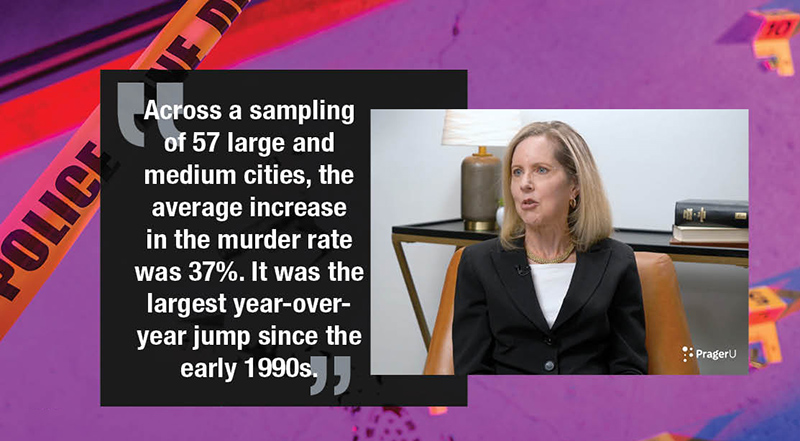
It is a testament to how grim a year 2020 was for America’s cities that shuttered schools were not our largest urban policy failure. That unfortunate distinction belongs to policing and public safety. Writing in the Wall Street Journal, Thomas W. Smith fellow and City Journal contributing editor Heather Mac Donald laid out the data on violent crime in 2020. Across a sampling of 57 large and medium-sized cities, the average increase in the murder rate was 37%. It was the largest year-over-year jump since the early 1990s. For the past decade, activists have assumed that the decline of crime was an inevitable fact of social life: that we could decriminalize quality-of-life offenses, abolish bail, and limit the effectiveness of police without any trade-off in public safety. Across the country, this hypothesis is being tested and, in case after case, found wanting.
Charles Fain Lehman, who recently joined MI as a fellow, explained to readers in the pages of City Journal, where he is also a contributing editor, that there is strong evidence that more cops on the beat means less crime. Indeed, it is “one of the most robust findings of empirical criminology, supported by study after study since at least the late 1990s.” This is a truth that police departments are struggling to honor as they shed officers at an alarming clip. This year, Minneapolis, Chicago, Milwaukee, and Atlanta have seen large declines in their police forces. In Seattle, nearly 100 police officers have left, citing fears for their safety and the city council’s anti-cop outlook as their primary motivations. Our own New York City has seen its force shrink 7% this year.

In addition to nudging the public toward a better understanding of the trade-offs we face in criminal justice policy, MI’s work goes to great lengths to remind Americans that the real victims in this debate tend not to be criminals but the communities they victimize. Rafael Mangual, MI’s deputy director of legal policy and City Journal contributing editor, made precisely this case in his New York Times op-ed “The Homicide Spike Is Real.” New York City has seen a 41% increase in homicides and a 97% increase in shootings this year, but the carnage was overwhelmingly concentrated in disadvantaged black and Latino neighborhoods. As Mangual notes in the piece, however, “statistics are poor stand-ins for the lives cut short, the families torn apart, and the innocence stolen from the souls of children—like the 6-year-old girl whose father was gunned down right before her eyes as they crossed a Bronx street, hand in hand, in broad daylight.” While New York City’s backsliding on crime can be explained by certain statistics, like the 7% decline in the police force and a $1 billion budget cut, it cannot be fully understood without an appreciation for the tragedies that become all too common in violent cities.
If declining crime was a path toward economic regeneration for our country’s cities, a new crime wave would endanger both individual cities and the nation as a whole. Cities must do their part in making themselves safe for prosperity. But they will need some help from the federal government along the way—first, by accelerating vaccine distribution to end the pandemic, and then by committing to long-term reforms that will revive productivity growth, empower a new generation of entrepreneurs, and prove that many of America’s greatest problems will be solved from the ground up, as they always have been.
When President Joe Biden took office in January, there was widespread agreement on what his top priorities ought to be: end the pandemic as quickly as possible while providing targeted economic relief to the unemployed. The American Rescue Plan (ARP) combines some worthwhile proposals—more money for vaccines, for instance—with others that have little to do with the crisis at hand. Of the ARP’s $1.9 trillion, $130 billion is aimed at vaccines while $350 billion is earmarked for unconditional aid to state and local governments, regardless of need. Schools will receive $130 billion, though reports suggest that they expect to spend only one-third of that money this year, belying the idea that these funds will go toward rapid reopenings.
Relative to the size of the national economy, America’s public debt has reached levels unseen since World War II. At the end of that conflict, the United States demobilized the war effort and began an era of rapid economic growth that gradually eased the debt burden. Today, the question is whether America is capable of winding down the “emergency” welfare state it has built over the last year and igniting an era of rapid growth and widespread opportunity. The alternative would be a future of diminished expectations, with businesses increasingly dependent on federal largesse and rising class conflict over a shrinking economic pie. The choice, in other words, is stagnation or renewal.
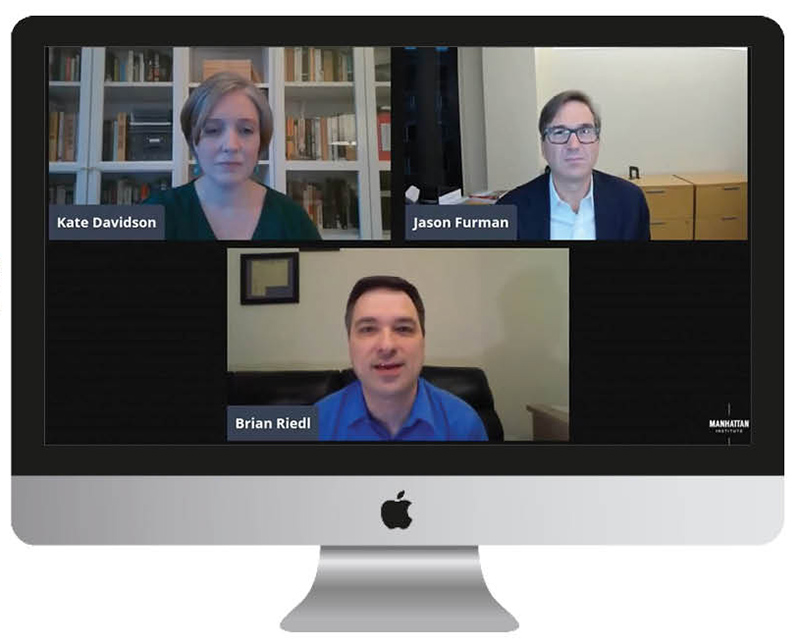
In print articles, broadcast appearances, and debates with high-profile figures, MI senior fellow Brian Riedl has been a leading voice calling attention to the risks of runaway spending. Riedl discussed the drawbacks of a fire-hose approach to federal spending in commentary for the Washington Post, the Daily Beast, and The Dispatch, as well as in an MI-hosted debate with former Council of Economic Advisers chairman Jason Furman. Current conditions, Riedl notes, are not guaranteed to last, and should interest rates rise or inflation set in, the cost of servicing our current debt while meeting retirement obligations would be crippling. Once the economy is up and running, political leaders from both parties should look for an equitable path toward entitlement reform that both cuts costs and raises revenues.
“Relative to the size of the national economy, America’s public debt has reached levels unseen since World War II.”
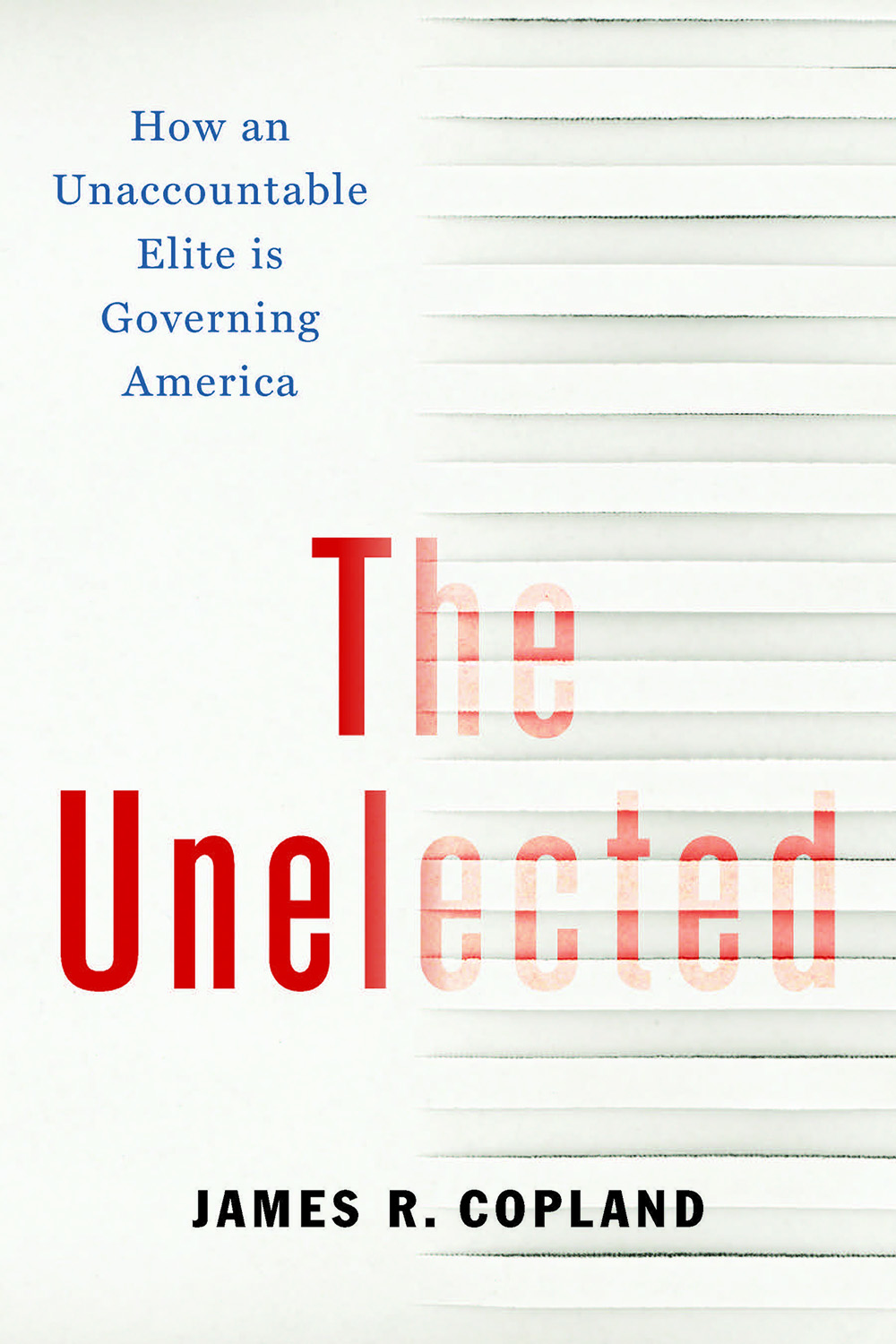 The Biden administration should avoid repeating the Obama administration’s strategy of legislating through executive fiat. In his brief on executive-branch restraint, senior fellow and director of legal policy James R. Copland makes the case for respecting the federal government’s separation of powers—echoing the themes from his recently released book, The Unelected. Copland took to the pages of the Wall Street Journal to draw particular attention to the Biden administration’s decision to consider allowing third-party groups to benefit from settlements reached between the government’s prosecutors and private parties. Americans rightfully pride themselves on a judicial system that insulates prosecutions from political pressure, a task that will become much harder if well-connected interest groups come to view prosecutions as lucrative revenue streams.
The Biden administration should avoid repeating the Obama administration’s strategy of legislating through executive fiat. In his brief on executive-branch restraint, senior fellow and director of legal policy James R. Copland makes the case for respecting the federal government’s separation of powers—echoing the themes from his recently released book, The Unelected. Copland took to the pages of the Wall Street Journal to draw particular attention to the Biden administration’s decision to consider allowing third-party groups to benefit from settlements reached between the government’s prosecutors and private parties. Americans rightfully pride themselves on a judicial system that insulates prosecutions from political pressure, a task that will become much harder if well-connected interest groups come to view prosecutions as lucrative revenue streams.
While Copland continues to monitor the new administration’s executive actions, senior fellow Mark P. Mills has been a leading voice in the debate over its energy agenda. Biden has pledged a $2 trillion investment to “green” the American economy. Mills has testified before both the U.S. Senate Committee on Energy & Natural Resources and the U.S. House Committee on Energy & Commerce, offering a clear-eyed vision of America’s energy outlook. Large-scale government intervention into several of America’s largest industries is a path to little progress and enormous waste, a retread of earlier boondoggles for alternative fuels and solar panel manufacturers. Mills has run the numbers showing that a $2 billion investment from the United States would be a boon for countries exporting rare minerals and the Chinese firms that dominate the solar panel and wind turbine industries, but would fall well short of bringing our electrical grid to zero net emissions by 2035.
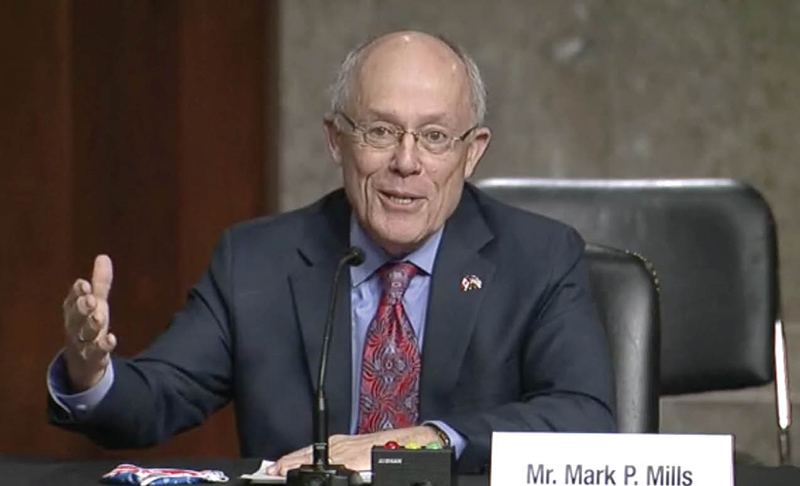
New York City is no stranger to crises. After 9/11 and the 2008 financial crisis, Gotham bounced back much faster than people thought possible. This has led some commentators to believe that the current wave of pearl-clutching over the fate of New York City is decidedly overblown. But our appreciation for New York’s strong fundamentals— its talented labor pool and strong appeal as a lifestyle destination—should be tempered with an understanding of how small shifts in the tax base and public policy can drive changes that take on a life of their own.
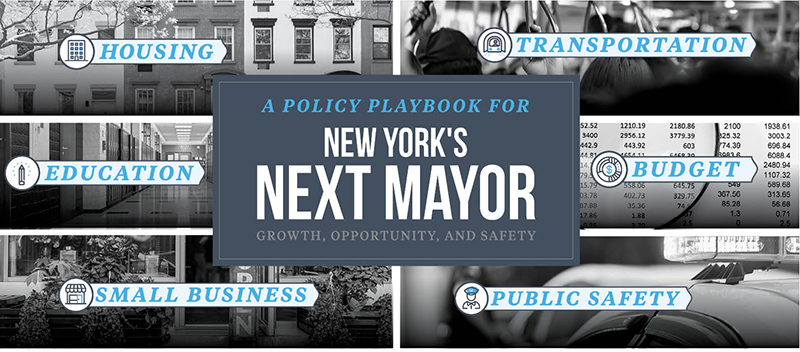
In a series of reports for our New York City: Reborn Initiative, MI scholars have offered a road map to help New York’s next mayor guide the city through the latest crisis. Steven Malanga, the George M. Yeager fellow at the Manhattan Institute and senior editor for City Journal, has argued for years that the city was spending irresponsibly during good times, forgoing investments and genuine reforms in favor of ever-sweeter deals for the city’s workforce. In his report “A Budget Plan for the Next Mayor,” Malanga notes that during Mayor Bill de Blasio’s tenure, the city has increased its budget by 30% and its payroll by 11%. The rate of wage growth for New York City employees and the generosity of its post-retirement health-care benefits far exceeds that of the city’s private employers and other major cities around the country. But as the cost of government was rising during these de Blasio years, the quality of several bread-and-butter urban services deteriorated. Subway delays and overcrowding became a recurring tabloid theme. New social media accounts were made with the sole purpose of capturing the small mountains of trash that have colonized city corners. New York City’s next mayor will have to refocus on the basics. Getting labor costs under control will be a crucial early step.
“But our appreciation for New York’s strong fundamentals—its talented labor pool and strong appeal as a lifestyle destination—should be tempered with an understanding of how small shifts in the tax base and public policy can drive changes that take on a life of their own.”
The city will then have to turn its attention to the workforce of tomorrow and prepare city schools to fully reopen. Indeed, many New Yorkers are understandably frustrated with how public schools have reacted to the pandemic, dogmatically opposing reopenings and disregarding evidence showing little risk—and engendering massive costs. Ray Domanico, director of education policy for MI, has been a regular in the New York Post and Daily News throughout the pandemic, presenting the evidence for in-person learning and sharing some of the strategies that parochial and charter schools have used to teach through the pandemic. In his brief on the future of the city’s schools, Domanico advocates a clean break from de Blasio’s zero-sum vision of education. Where other mayors worked hard to try to offer poor and disadvantaged students the same resources and options that are available to their wealthy peers, the de Blasio administration has focused its energies on dismantling merit-based schools and standardized testing. Rather than working to redistribute educational opportunity across the city’s racial and ethnic lines, a formula for embittering our politics, the city should make it possible for all children to receive a quality education—no matter what neighborhood they live in or how much money their parents make.

Improving the hit-or-miss nature of New York City’s schools would help the city retain young families, but bringing down the cost of housing is similarly vital. MI senior fellow Eric Kober spent decades in New York City’s Department of City Planning, watching successive mayors try to use public dollars and tax write-offs to paper over a housing shortage that was, at its core, a product of overregulation. Kober’s advice to de Blasio’s successor: save the public’s resources for problems the private sector won’t address, and change the rules to allow new housing to be built—a task that the private sector would gladly take on. In the pages of City Journal and the New York Post, Kober has shared his original and carefully crafted ideas to fix the Mandatory Inclusionary Housing program and brought to light the many ways the city council uses the zoning code to service well-connected constituencies. Even among other large and desirable metro areas, New York stood out in the 2010s for not building anywhere near enough housing to keep up with new jobs.

All across the country, 2021 is a year for new beginnings. From city halls and state capitols to the halls of Congress, MI believes that there are many worthy causes for sincere reformers to champion. But the danger is that many public officials will co-opt the language of reform for the cause of a larger, more intrusive, government that serves politically connected insiders at the expense of the public interest. America needs government at all levels to perform its core functions more efficiently and transparently. This means keeping government focused on its proper aims and empowering the American people.
Reihan Salam
President, Manhattan Institute
Are you interested in supporting the Manhattan Institute’s public-interest research and journalism? As a 501(c)(3) nonprofit, donations in support of MI and its scholars’ work are fully tax-deductible as provided by law (EIN #13-2912529).
